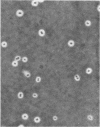Abstract
Foster, J. W. (The University of Texas, Austin), and Richard H. Davis. A methane-dependent coccus, with notes on classification and nomenclature of obligate, methane-utilizing bacteria. J. Bacteriol. 91:1924–1931. 1966.—A new coccus-shaped bacterium capable of aerobic growth at the expense of methane or methanol in a mineral salts medium is described. The organism did not grow at the expense of any of the conventional substrates or homologous hydrocarbons tested. It is gram-negative, nonmotile, and thermotolerant. It grows well at 50 C, optimally at 37 C, but does not grow at 55 C. The cells are encapsulated and have a characteristic diplococcoid arrangement. Washed, “resting-cell” suspensions oxidized certain primary alcohols and short-chain alkanes, an example of “nongrowth oxidation.” Of the methane-C utilized, 86% was “fixed” in organic form; the remainder was oxidized to CO2. The guanine-cytosine content of the extracted deoxyribonucleic acid was 62.5%. Obligate methane-utilizing bacteria are considered as “one-carbon” organisms rather than hydrocarbon utilizers. The assimilation pathway in the obligate methane-methanol bacteria is different from that in the facultative methanol utilizers. Nomenclatural problems arising from the use of the prefix “Methano-” to denote both bacteria that oxidize methane and bacteria that produce methane are discussed. The obligate, one-carbon, methane-methanol bacteria are considered as “methyl” utilizers, and the prefix “Methylo-” is suggested as a solution to the problem of generic cognomens. “Methylococcus capsulatus” gen. n., sp. n. is the name proposed for the new methane coccus.
Full text
PDF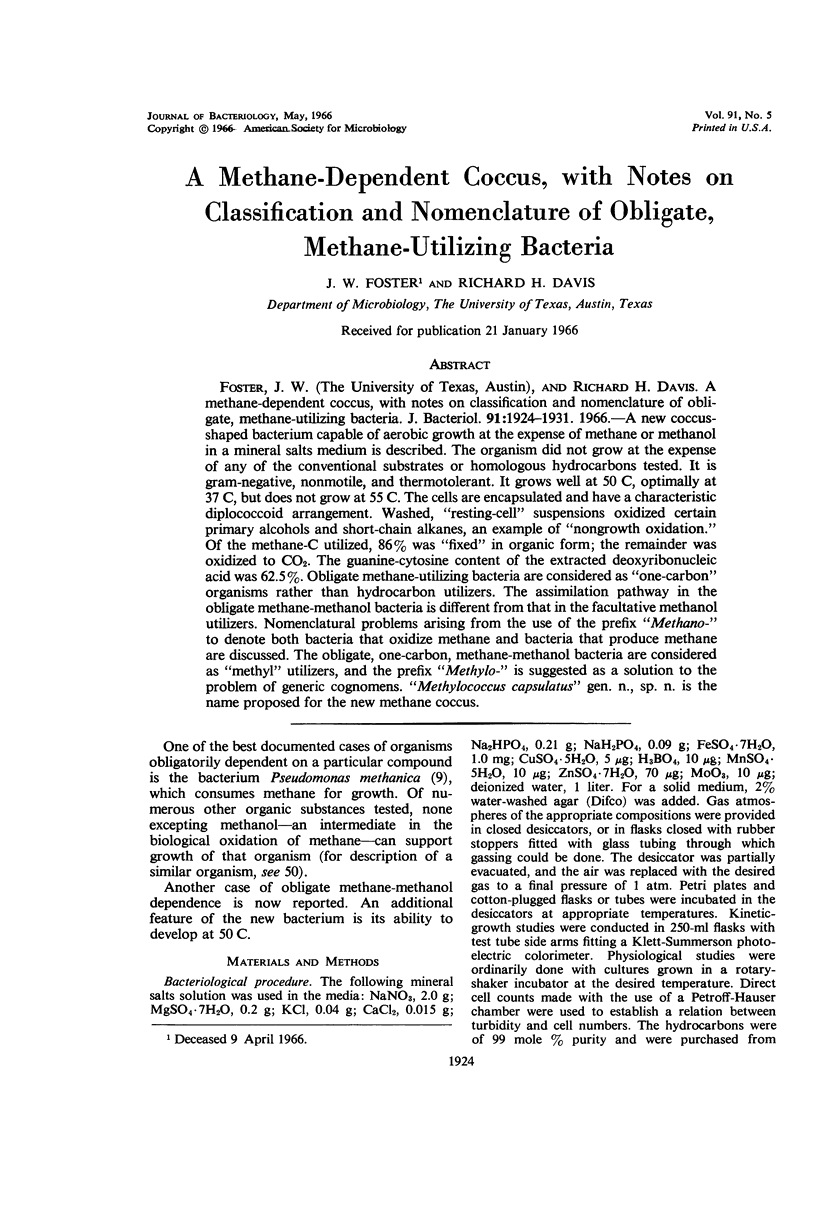
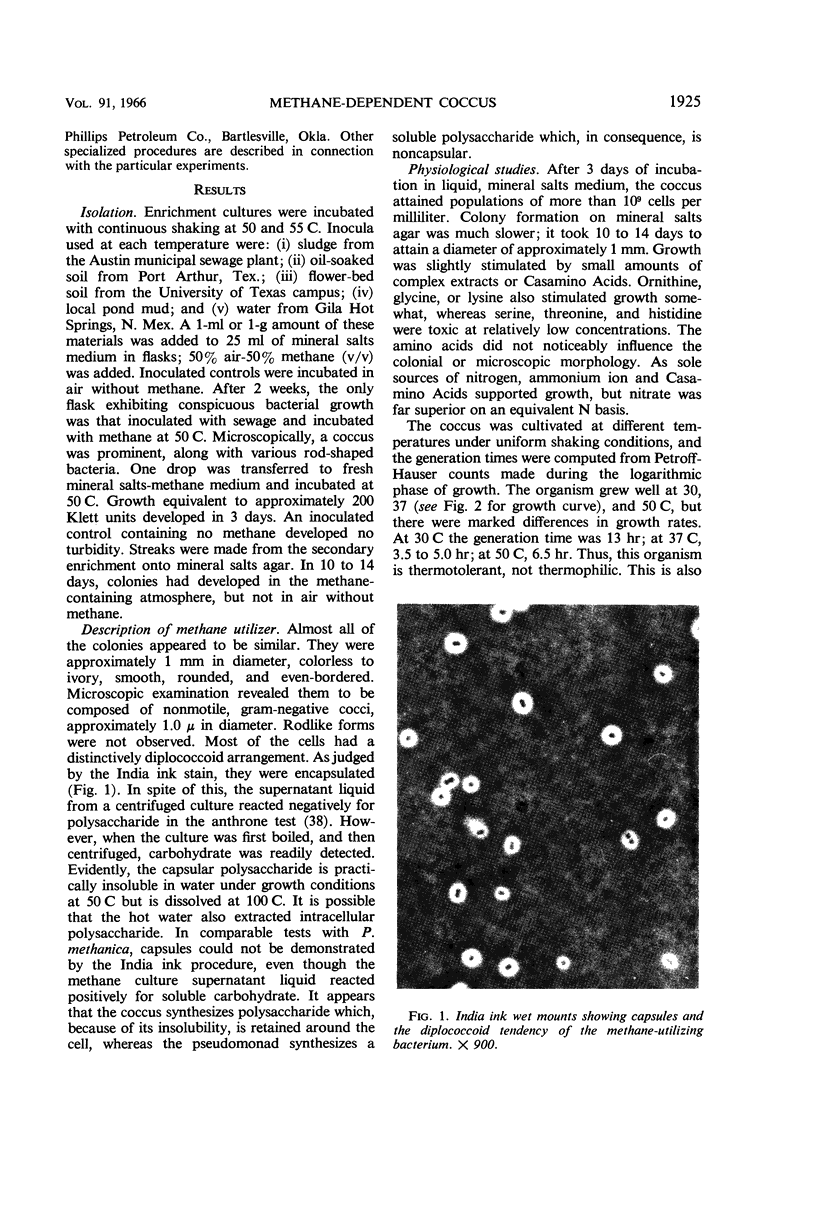
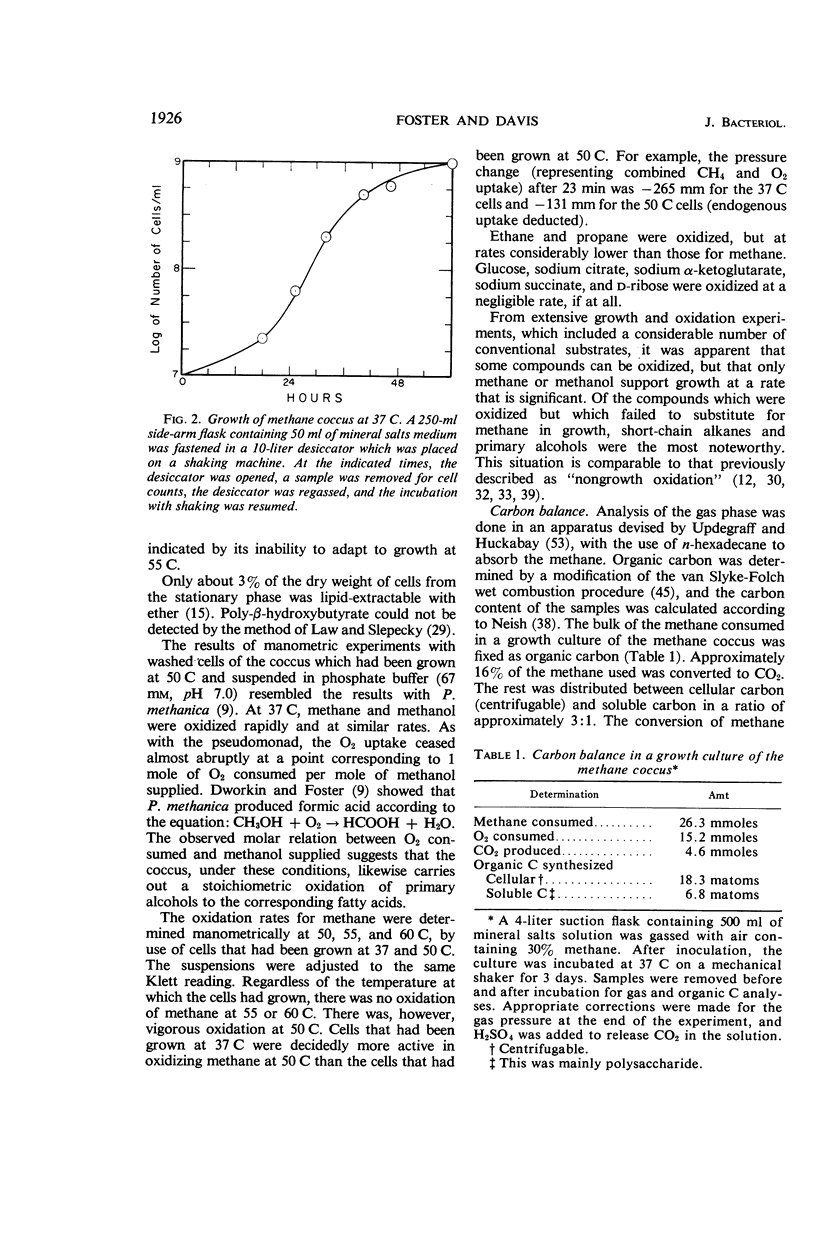
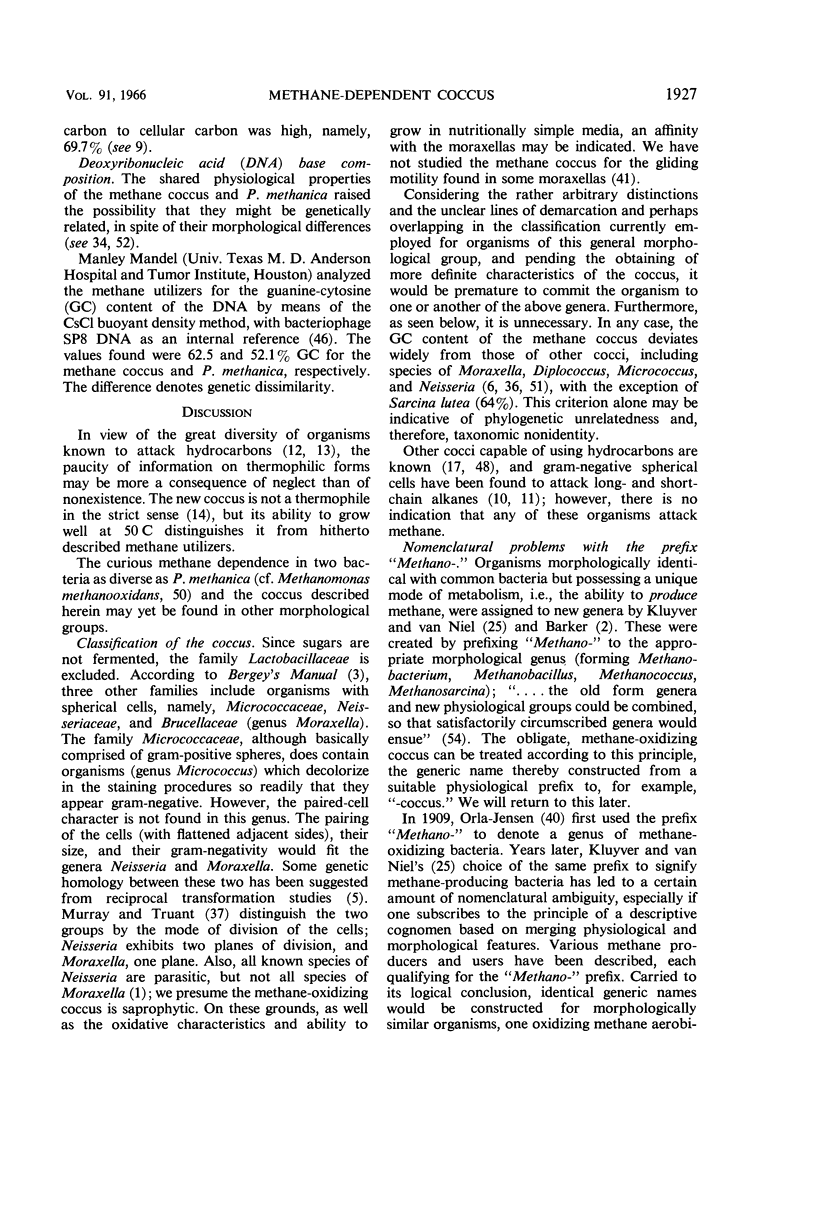
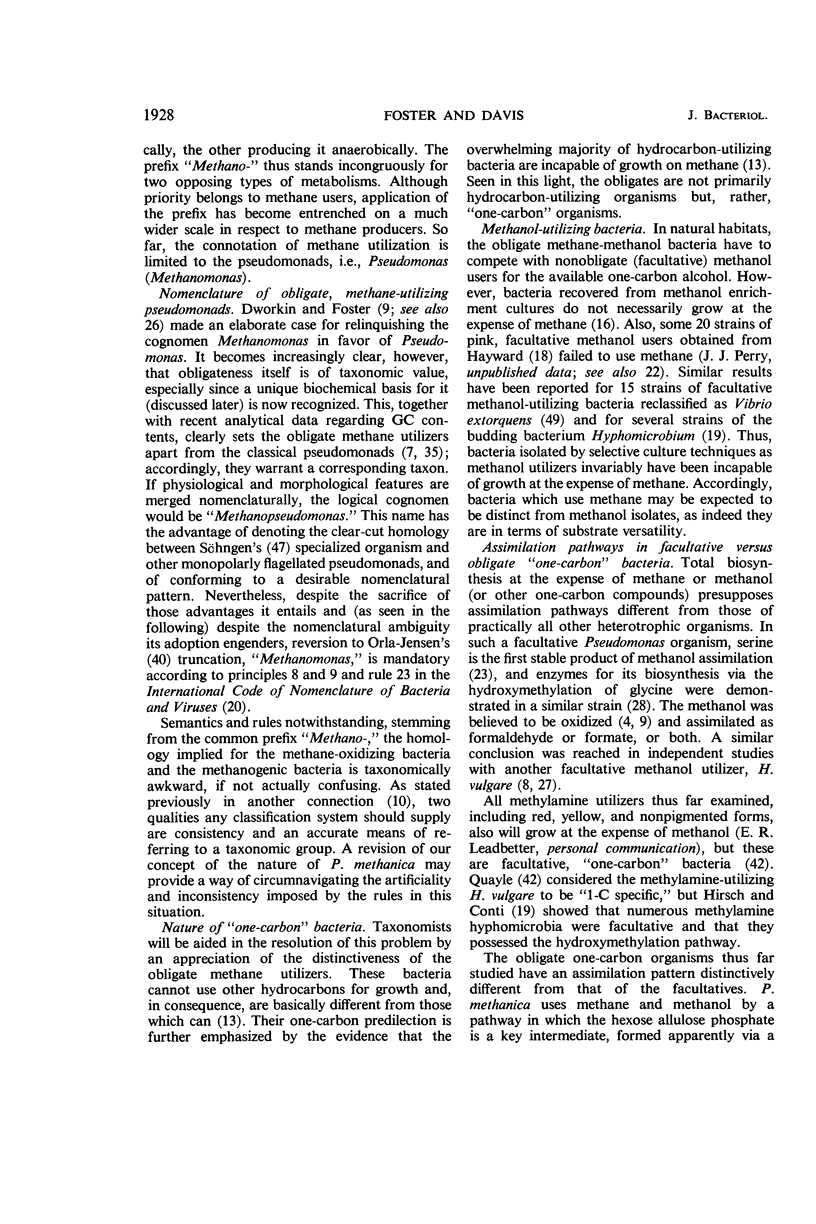
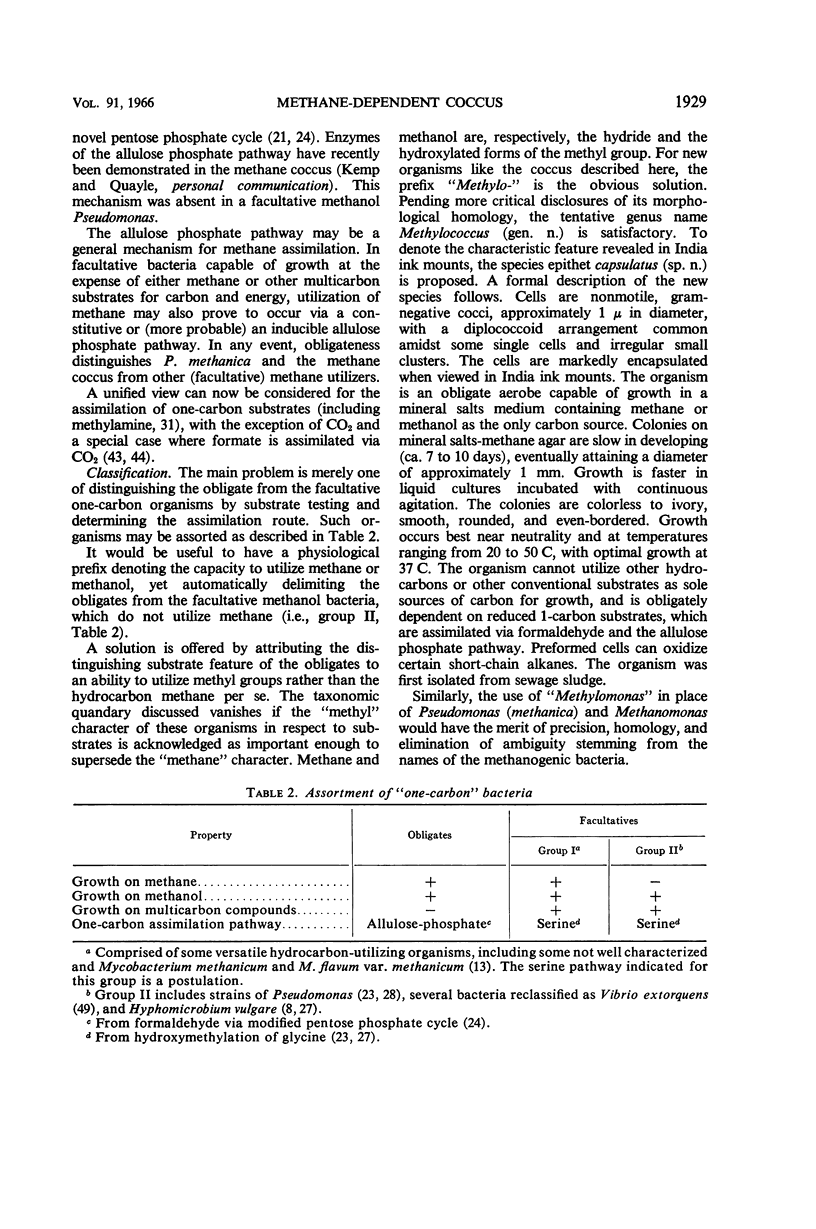
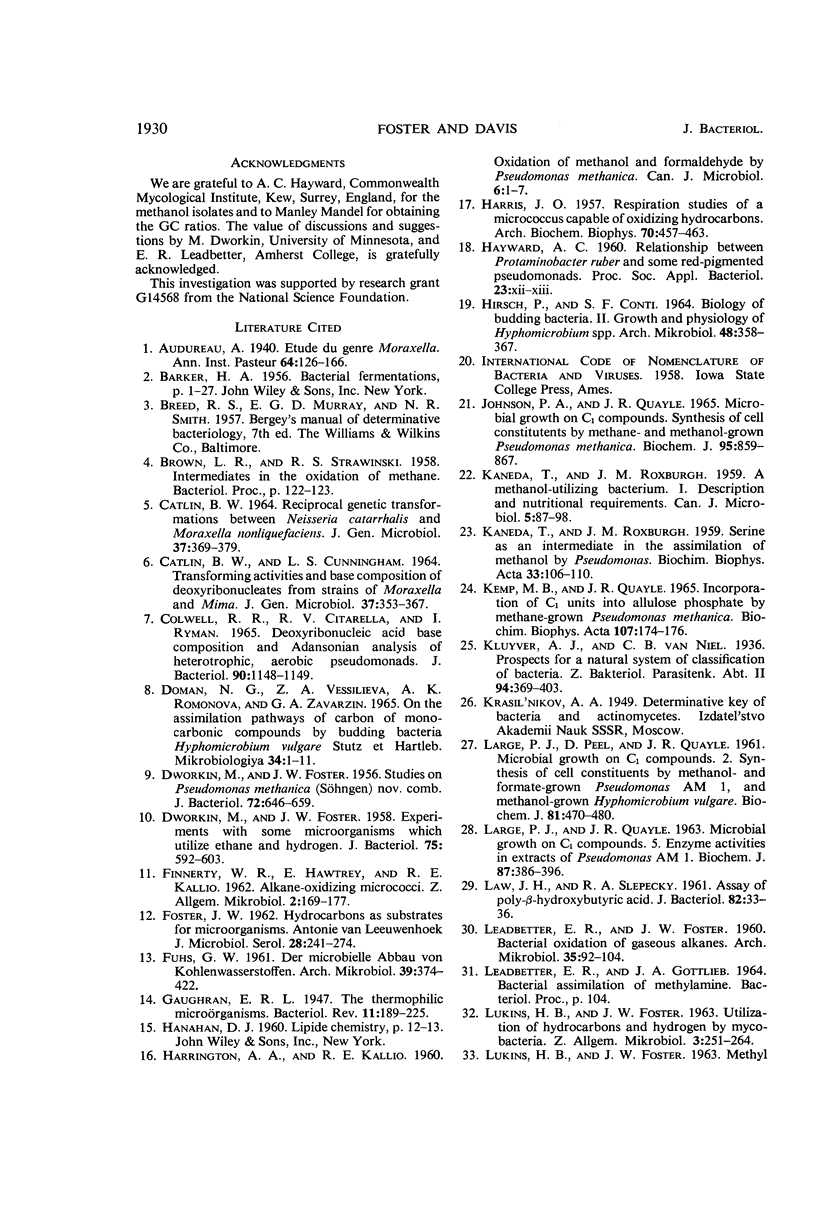
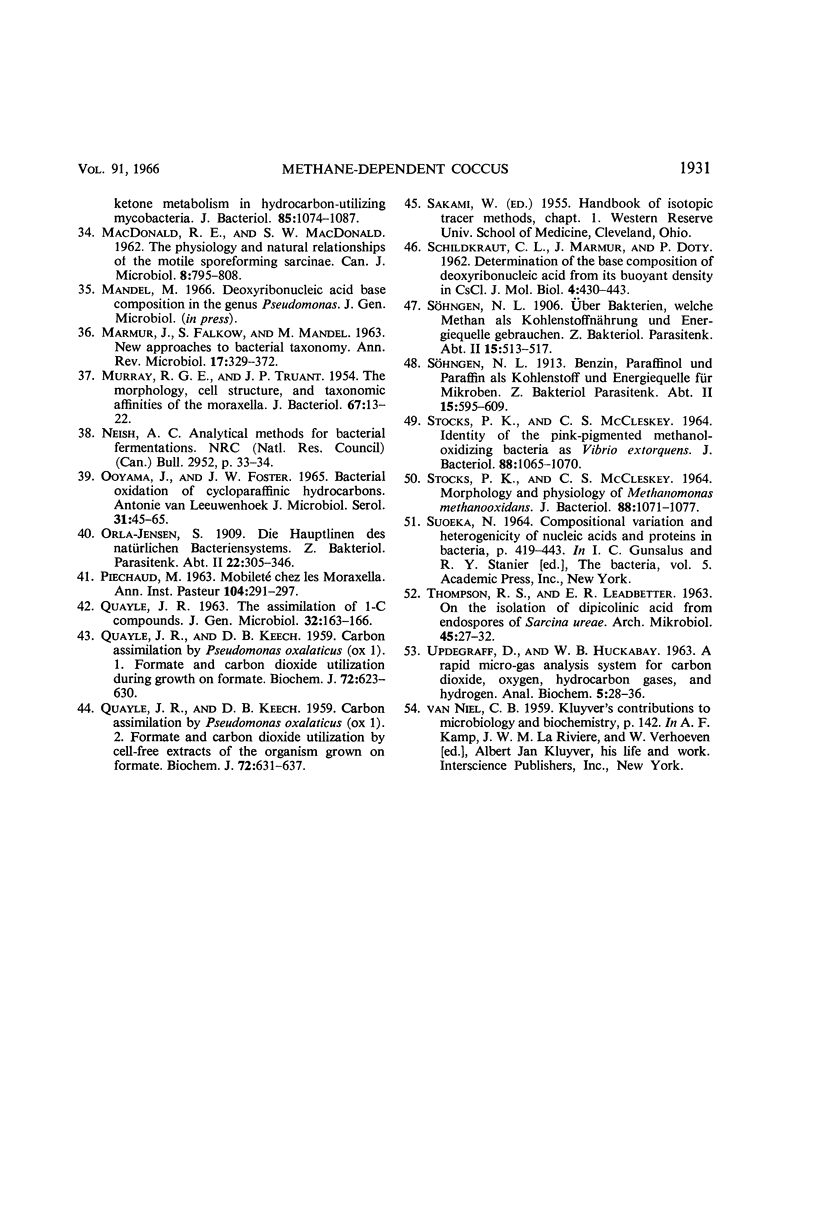
Images in this article
Selected References
These references are in PubMed. This may not be the complete list of references from this article.
- CATLIN B. W., CUNNINGHAM L. S. TRANSFORMING ACTIVITIES AND BASE COMPOSITION OF DEOXYRIBONUCLEATES FROM STRAINS OF MORAXELLA AND MIMA. J Gen Microbiol. 1964 Dec;37:353–367. doi: 10.1099/00221287-37-3-353. [DOI] [PubMed] [Google Scholar]
- CATLIN B. W. RECIPROCAL GENETIC TRANSFORMATION BETWEEN NEISSERIA CATARRHALIS AND MORAXELLA NONLIQUEFACIENS. J Gen Microbiol. 1964 Dec;37:369–379. doi: 10.1099/00221287-37-3-369. [DOI] [PubMed] [Google Scholar]
- Colwell R. R., Citarella R. V., Ryman I. Deoxyribonucleic acid base composition and Adansonian analysis of heterotrophic aerobic pseudomonads. J Bacteriol. 1965 Oct;90(4):1148–1149. doi: 10.1128/jb.90.4.1148-1149.1965. [DOI] [PMC free article] [PubMed] [Google Scholar]
- DWORKIN M., FOSTER J. W. Experiments with some microorganisms which utilize ethane and hydrogen. J Bacteriol. 1958 May;75(5):592–603. doi: 10.1128/jb.75.5.592-603.1958. [DOI] [PMC free article] [PubMed] [Google Scholar]
- DWORKIN M., FOSTER J. W. Studies on Pseudomonas methanica (Söhngen) nov. comb. J Bacteriol. 1956 Nov;72(5):646–659. doi: 10.1128/jb.72.5.646-659.1956. [DOI] [PMC free article] [PubMed] [Google Scholar]
- FOSTER J. W. Hydrocarbons as substrates for microorganisms. Antonie Van Leeuwenhoek. 1962;28:241–274. doi: 10.1007/BF02538739. [DOI] [PubMed] [Google Scholar]
- FUHS G. W. [Microbial catabolism of hydrocarbons]. Arch Mikrobiol. 1961;39:374–422. [PubMed] [Google Scholar]
- Gaughran E. R. THE THERMOPHILIC MICROORGANISMS. Bacteriol Rev. 1947 Sep;11(3):189–225. doi: 10.1128/br.11.3.189-225.1947. [DOI] [PMC free article] [PubMed] [Google Scholar]
- HARRINGTON A. A., KALLIO R. E. Oxidation of methanol and formaldehyde by pseudomonas methanica. Can J Microbiol. 1960 Feb;6:1–7. doi: 10.1139/m60-001. [DOI] [PubMed] [Google Scholar]
- HARRIS J. O. Respiration studies of a Micrococcus capable of oxidizing hydrocarbons. Arch Biochem Biophys. 1957 Aug;70(2):457–463. doi: 10.1016/0003-9861(57)90134-0. [DOI] [PubMed] [Google Scholar]
- HIRSCH P., CONTI S. F. BIOLOGY OF BUDDING BACTERIA. II. GROWTH AND NUTRITION OF HYPHOMICROBIUM SPP. Arch Mikrobiol. 1964 Jun 26;48:358–367. doi: 10.1007/BF00405979. [DOI] [PubMed] [Google Scholar]
- JOHNSON P. A., QUAYLE J. R. MICROBIAL GROWTH ON C1 COMPOUNDS. SYNTHESIS OF CELL CONSTITUENTS BY METHANE- AND METHANOL-GROWN PSEUDOMONAS METHANICA. Biochem J. 1965 Jun;95:859–867. doi: 10.1042/bj0950859. [DOI] [PMC free article] [PubMed] [Google Scholar]
- KANEDA T., ROXBURGH J. M. A methanol-utilizing Bacterium. I. Description and nutritional requirements. Can J Microbiol. 1959 Feb;5(1):87–98. doi: 10.1139/m59-011. [DOI] [PubMed] [Google Scholar]
- KANEDA T., ROXBURGH J. M. Serine as an intermediate in the assimilation of methanol by a Pseudomonas. Biochim Biophys Acta. 1959 May;33(1):106–110. doi: 10.1016/0006-3002(59)90503-7. [DOI] [PubMed] [Google Scholar]
- Kemp M. B., Quayle J. R. Incorporation of C1 units into allulose phosphate by methane-grown Pseudomonas methanica. Biochim Biophys Acta. 1965 Aug 24;107(1):174–176. doi: 10.1016/0304-4165(65)90415-0. [DOI] [PubMed] [Google Scholar]
- LARGE P. J., PEEL D., QUAYLE J. R. Microbial growth on C1 compounds. II. Synthesis of cell constituents by methanol- and formate-grown Pseudomonas AM 1, and methanol-grown Hyphomicrobium vulgare. Biochem J. 1961 Dec;81:470–480. doi: 10.1042/bj0810470. [DOI] [PMC free article] [PubMed] [Google Scholar]
- LAW J. H., SLEPECKY R. A. Assay of poly-beta-hydroxybutyric acid. J Bacteriol. 1961 Jul;82:33–36. doi: 10.1128/jb.82.1.33-36.1961. [DOI] [PMC free article] [PubMed] [Google Scholar]
- LEADBETTER E. R., FOSTER J. W. Bacterial oxidation of gaseous alkanes. Arch Mikrobiol. 1960;35:92–104. doi: 10.1007/BF00425597. [DOI] [PubMed] [Google Scholar]
- Large P. J., Quayle J. R. Microbial growth on C(1) compounds. 5. Enzyme activities in extracts of Pseudomonas AM1. Biochem J. 1963 May;87(2):386–396. doi: 10.1042/bj0870386. [DOI] [PMC free article] [PubMed] [Google Scholar]
- Lukins H. B., Foster J. W. Utilization of hydrocarbons and hydrogen by mycobacteria. Z Allg Mikrobiol. 1963;3(4):251–264. doi: 10.1002/jobm.3630030403. [DOI] [PubMed] [Google Scholar]
- MARMUR J., FALKOW S., MANDEL M. NEW APPROACHES TO BACTERIAL TAXONOMY. Annu Rev Microbiol. 1963;17:329–372. doi: 10.1146/annurev.mi.17.100163.001553. [DOI] [PubMed] [Google Scholar]
- MURRAY G. E., TRUANT J. P. The morphology, cell structure, and taxonomic affinities of the Moraxella. J Bacteriol. 1954 Jan;67(1):13–22. doi: 10.1128/jb.67.1.13-22.1954. [DOI] [PMC free article] [PubMed] [Google Scholar]
- OOYAMA J., FOSTER J. W. BACTERIAL OXIDATION OF CYCLOPARAFFINIC HYDROCARBONS. Antonie Van Leeuwenhoek. 1965;31:45–65. doi: 10.1007/BF02045875. [DOI] [PubMed] [Google Scholar]
- PIECHAUD M. [Motility of the Moraxella]. Ann Inst Pasteur (Paris) 1963 Feb;104:291–297. [PubMed] [Google Scholar]
- QUAYLE J. R., KEECH D. B. Carbon assimilation by Pseudomonas oxalaticus (OX 1). 1. Formate and carbon dioxide utilization during growth on formate. Biochem J. 1959 Aug;72:623–630. doi: 10.1042/bj0720623. [DOI] [PMC free article] [PubMed] [Google Scholar]
- QUAYLE J. R., KEECH D. B. Carbon assimilation by Pseudomonas oxalaticus (OX 1). 2. Formate and carbon dioxide utilization by cell-free extracts of the organism grown on formate. Biochem J. 1959 Aug;72:631–637. doi: 10.1042/bj0720631. [DOI] [PMC free article] [PubMed] [Google Scholar]
- QUAYLE J. R. THE ASSIMILATION OF 1-C COMPOUNDS. J Gen Microbiol. 1963 Aug;32:163–166. doi: 10.1099/00221287-32-2-163. [DOI] [PubMed] [Google Scholar]
- SCHILDKRAUT C. L., MARMUR J., DOTY P. Determination of the base composition of deoxyribonucleic acid from its buoyant density in CsCl. J Mol Biol. 1962 Jun;4:430–443. doi: 10.1016/s0022-2836(62)80100-4. [DOI] [PubMed] [Google Scholar]
- STOCKS P. K., MCCLESKEY C. S. IDENTITY OF THE PINK-PIGMENTED METHANOL-OXIDIZING BACTERIA AS VIBRIO EXTORQUENS. J Bacteriol. 1964 Oct;88:1065–1070. doi: 10.1128/jb.88.4.1065-1070.1964. [DOI] [PMC free article] [PubMed] [Google Scholar]
- STOCKS P. K., MCCLESKEY C. S. MORPHOLOGY AND PHYSIOLOGY OF METHANOMONAS METHANOOXIDANS. J Bacteriol. 1964 Oct;88:1071–1077. doi: 10.1128/jb.88.4.1071-1077.1964. [DOI] [PMC free article] [PubMed] [Google Scholar]
- THOMPSON R. S., LEADBETTER E. R. On the isolation of dipicolinic acid fromhendospores of Sarcina ureae. Arch Mikrobiol. 1963;45:27–32. doi: 10.1007/BF00410294. [DOI] [PubMed] [Google Scholar]
- UPDEGRAFF D. M., HUCKABAY W. B. A rapid micro gas analysis system for carbon dioxide, oxygen, hydrocarbon gases, and hydrogen. Anal Biochem. 1963 Jan;5:28–36. doi: 10.1016/0003-2697(63)90054-x. [DOI] [PubMed] [Google Scholar]



